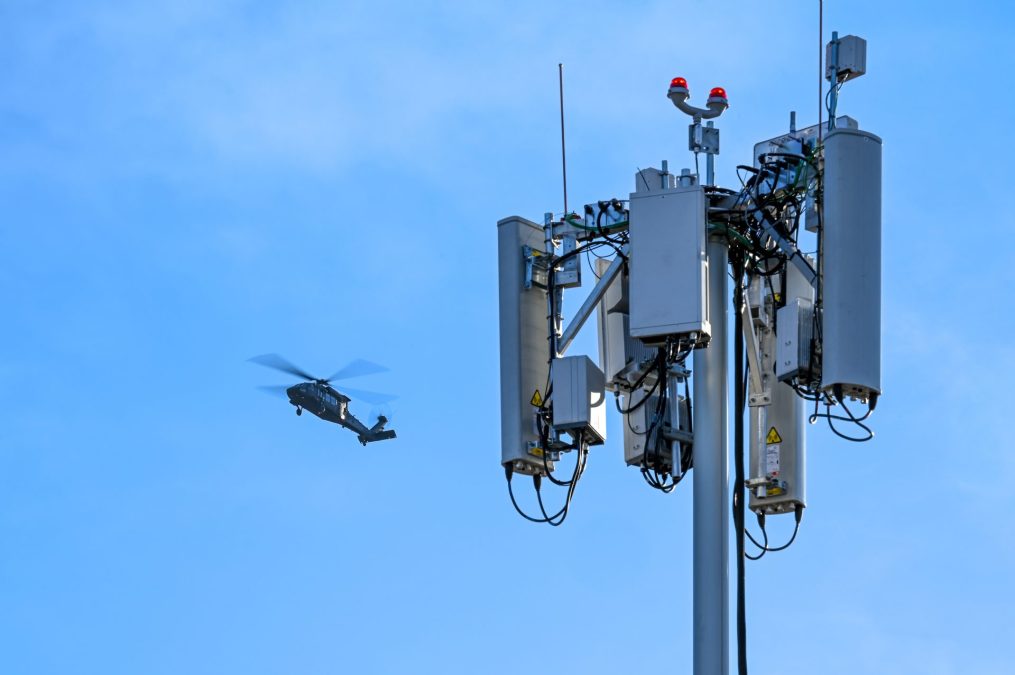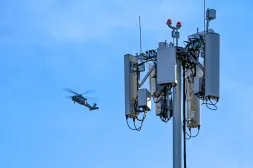Beyond 5G: Pentagon sets sights on next-generation wireless tech with new projects

As it looks at how to provide warfighters with readily available 5G communications, the Pentagon’s FutureG office is concurrently pursuing applied research into new technologies that will serve as the department’s foundation for accessing future generations of wireless capabilities.
The office, which is in charge of research-and-development efforts for advanced wireless network capabilities, has three projects underway in its “Beyond 5G” portfolio that it plans to carry out through at least fiscal 2025. Collectively, the programs aim to enhance the Pentagon’s ability to connect and maneuver within the electromagnetic spectrum, Tom Rondeau, principal director for FutureG at the Pentagon, told DefenseScoop.
“We have more readily available access to spectrum than we ever have, and it keeps increasing. So our ability to maneuver within the spectrum from a single system keeps advancing,” Rondeau said in a recent interview on the sidelines of NDIA’s Emerging Technologies for Defense Conference and Exhibition.
Future generations of wireless communications will use higher frequencies on the spectrum than their predecessors, therefore providing faster connections with lower latency compared to 5G and others. The tech is also expected to be highly scalable, allowing for devices to use multiple connections simultaneously — meaning they can stay online even if one network source is interrupted or interfered with.
The Beyond 5G portfolio largely focuses on R&D to leverage these advancements for military applications. The Office of the Secretary of Defense requested $55.1 million in fiscal 2024 to fund the portfolio’s work — including the three applied research projects.
One of those efforts is to develop a Unlimited Software-defined Radio that isn’t bound by hardware and previous generations’ architecture and implementation constraints. The capability will let users leverage any part of the spectrum with any waveform, improving overall spectrum management capabilities, Rondeau said.
“Spectrum is a maneuver space, and so we need to be able to take advantage of that,” he said. “We still think of spectrum and warfighting in terms of, ‘What channel are you on?’ … We really need to be flexible and maneuverable around all these.”
Once warfighters have access to more spectrum, they’ll need to easily navigate the network without worrying about whether or not they’re on the right communications channel. Rondeau explained that another research project — Hyper-dimensional Software-defined Networks — will enable autonomous optimization of wireless network operations to solve the problem.
“The network needs to tell the system what to do,” he said, adding that the technology will “be able to understand not what your radio needs to do, but what everyone needs to do. And so, how do I look across this from the different physical access that we have, the geometries of where you’re at?”
It’s a multidimensional problem that requires the FutureG office to consider how both terrestrial and non-terrestrial networks can optimize across several domains at once, he noted.
Speaking during a panel discussion at the NDIA conference, Rondeau emphasized that non-terrestrial networks — including satellite constellations and airborne platforms — are key to providing warfighters with ubiquitous, secure and instant communications in austere environments.
“It’s not just satellite constellations, it’s not just the proliferated [low-Earth orbit] concepts — it’s all the layers above us,” Rondeau said. “It can be [unmanned aerial vehicles] enabling these systems, or high-altitude platforms and balloons that might be able to be subset systems to pLEO all the way up to [geosynchronous orbit] as part of our hybrid access to infrastructure.”
The third research project underway at the FutureG office is development of Mobile Internet Protocol advancements so that new systems can integrate with the rest of the network, Rondeau told DefenseScoop.
Traditional internet protocols were created for legacy devices that are designed to be plugged into fixed sites, such as computers. Even mobile phones that roam across coverage areas are connected to a centralized cellular network that works to manage how a device stays connected, he explained.
Therefore, the FutureG office is trying to understand “the next generation of internet protocol that is fundamentally rooted in mobility,” as well as how it should be managed, Rondeau said.
Overall, the three projects represent a hard engineering and technical problem for the FutureG office, especially as it looks to scale capabilities across the entire Defense Department.
“When you’re talking about what waveform to use, what frequency to use [and] power consumption, … if you’re trying to optimize all these simultaneously, they’re actually competing goals,” he explained. “Then, as you’re trying to do this across multiple — maybe hundreds of thousands — of radio systems in the future, all operating in the battlefield, now you’re trying to schedule who gets what, when, what resources go to what place and all these things.”
Another challenge is the unstable fiscal environment that has plagued the Defense Department and other federal agencies in recent years, in addition to a lack of transparency from the White House and Congress regarding potential funding cuts, he said. Uncertainty in the budgetary decisions could lead the FutureG office into a more conservative approach to how it spends money, which in turn could stifle the advancement and delivery of new technologies, he added.
In OSD’s budget request for FY ’25, the Beyond 5G portfolio would receive $38.5 million — $16.6 million less than the previous year’s request. According to budget documents, the decrease was due to “a directed reduction that was applied to meet DOD overall funding benchmarks.”
If approved by lawmakers, the 2025 funding would go towards continued development of the office’s ongoing programs, as well as adding new projects focused on contested logistics, open-source software solutions and multi-site FutureG experimentation, the documents stated.
“If they’re going to cut my budget, then tell me about it. Don’t surprise us. And if it’s a non-starter to crawl back the budget, at least I’ve got time to properly plan,” Rondeau said. “It’s that level of uncertainty that prevents us from really creating a space for the innovation that I need.”






